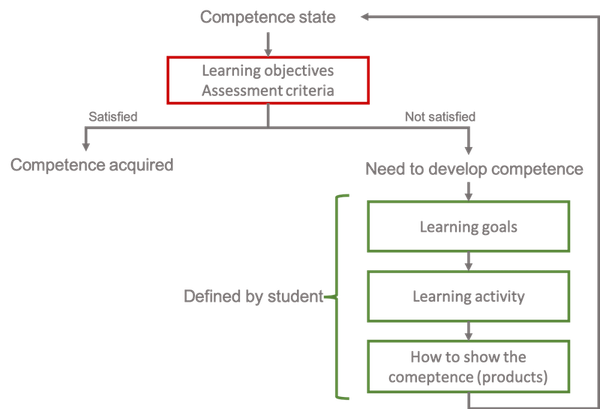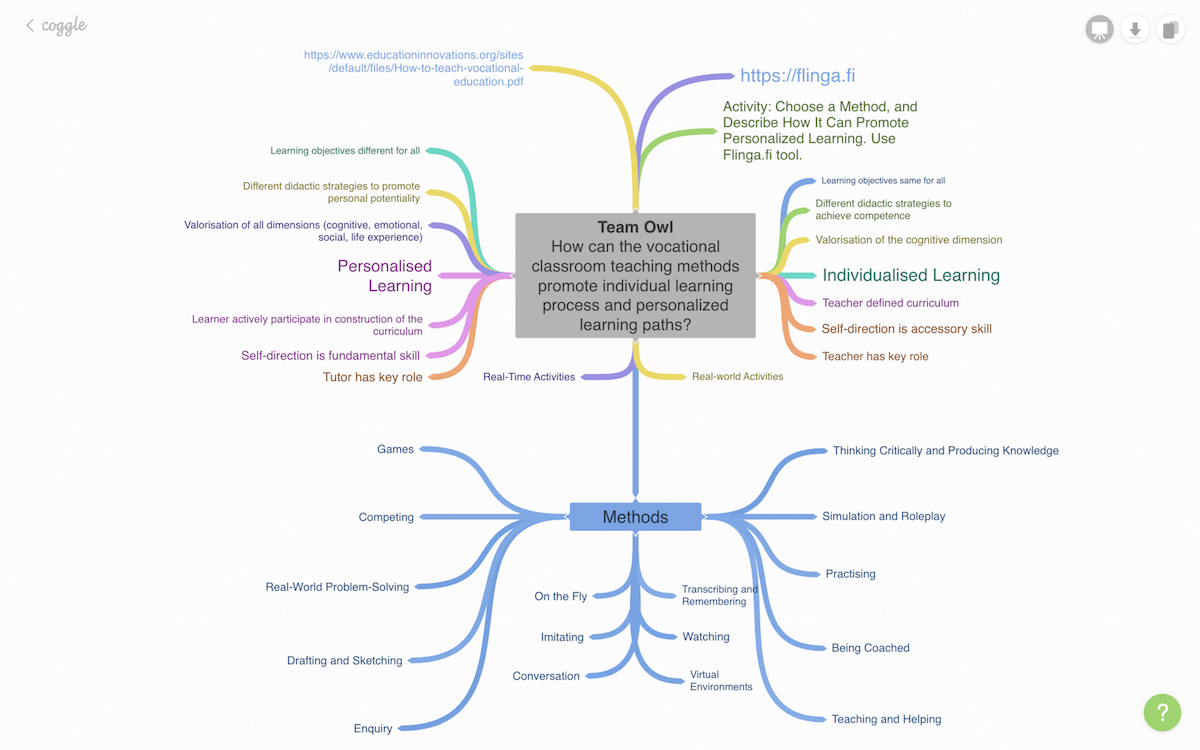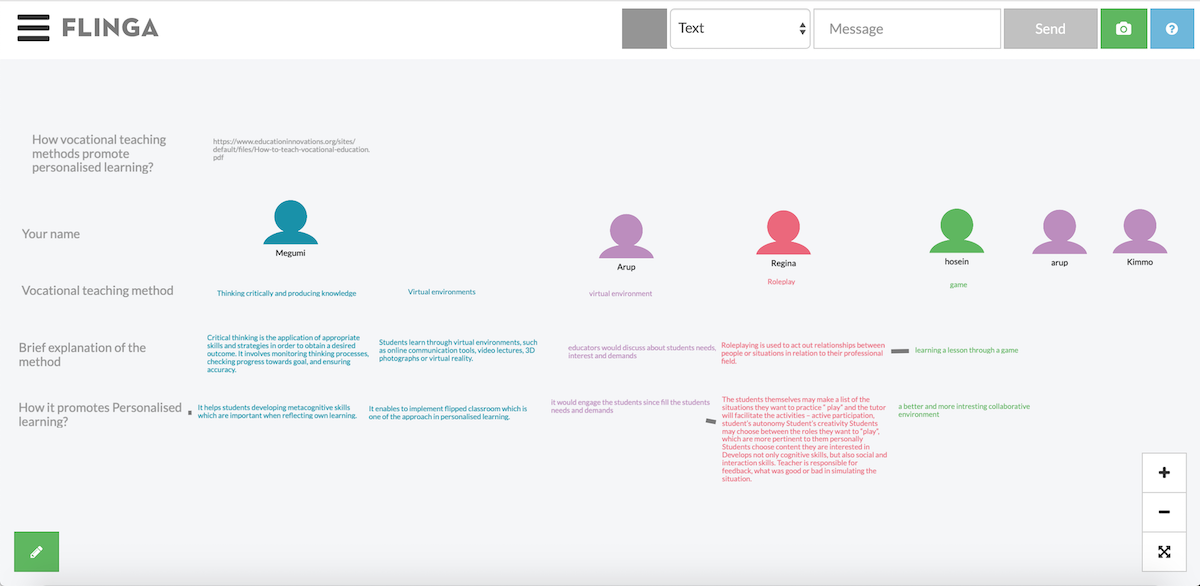Teaching and guiding: Implementation 2
Learning from teaching
In the following section, I describe what our group has done for our teaching session and what I have learned from preparation and implementation processes.
Topic
How can the vocational classroom teaching methods promote individual learning process and personalized learning paths?
This week's topic was quite broad and abstract. We devided the topic into the smaller parts.
Differences between individualised learning and personalised learning
While familiarising ourselves with the topic, we came across the similar terms, personalised learning and individualised learning. Both terms are very broad and abstract so sometimes they are used interchangeably. But we found some differences between them. Main differences are in: learning goals, didactic strategies, dimension of valorisation, curriculum, self-direction and teacher role (Classroomaid, 2012). While individual leaning focuses on cognitive dimension and competence in learning, personalised learning take every dimension of a person, including cognition, emotion, social and life experience, into account.
For instance:
In individualised learning, learning goals are the same (students should learn the same topic and develop the same competence), while in personalised learning, learning goals are different for each student (students define learning objectives by themselves based on their interests and life experiences).
In individualised learning, different didactic strategies are applied in order to enhance acquiring competences in individual learning, while in personalised learning, different didactic strategies are appleid in order to promote personal potentiality.
In individual learning, curriculum is designed by teacher, while in personalised learning, curriculum is designed jointly by teacher and student.
In individual learning, student’s self-direction is an accessary skill and teacher’s role is the key, while in personalised learning student’s self-direction is fundamental and tutor’s role is the key.
Personalised learning in competence based vocational education
We decided to focus on personalised learning. Building our own personalised learning paths is crucial in the life-long learning context, where we need to rapidly acquire new knowledge to keep ourselves up to date in the ever changing society (Carchiolo, Longheu & Malgeri, 2010). Especially vocational education institution should always open to individuals in the field to develop skills they need and vocational teachers should understand how to guide students’ personalised learning paths.
Key aspect in personalised learning is student have autonomy in their learning. Personalised learning requires mutual responsibility among teachers, teachers and students, and among students. Teachers are responsible for designing and implementing a flexible curriculum that 1) engages all individual students and 2) allows to implement differentiated teaching and learning that addresses group and individual student needs, and 3) motivates and develops students’ capacities as an independent learner (Prain et al., 2013). For example, in the flexible curriculum, content (what students learn), process (how to learn), and products (how to show competence) can be differentiated (Prain et al., 2013). In addition, teachers are responsible for providing students with feedback so that they can reflect on their learning.
Students, on the other hand, are responsible for their own learning through participation in building curriculum, defining learning goals, monitoring and adjusting own learning paths. It is important for students to get feedback from teacher and peer students so that they are able to reflect on their learning. For successful personalised learning, students should develop self-regulated learning skill. Self-regulated learning includes the following phases: 1) forethought, planning and activation (planning and enacting behaviour such as effort and persistence); 2) monitoring (such as tracking task requirements); 3) control (such as adapting behavioural strategies to ensure task completion); and 4) reflection (such as use of self-assessing strategies achieve task requirements) (Pintrich, 2004). It allows students to become active participants in their own learning processes and to have ownership of their own learning paths.
In personalised learning in competence based vocational education, students may define their own learning paths while comparing desired outcomes including contents and level of understanding (see my blog about constructive alignment) and the current competence state (Heller, Steiner, Hockemeyer & Albert, 2006). The following figure shows one of the potential models of personalised learning in competence based vocational education.
One of the common approaches of personalised learning is flipped classroom. Students learn the contents before hand and then discuss their own learning in the classroom. In this way, students can focus on the particular area which they want to develop, discuss in class or ask questions from the teacher, and reflect on their own learning. In the classroom, “learning by doing” type of activities, such as project-based learning, are useful in personalised learning (Järvelä, 2006). While engaging in such activities related to the topic studied, students identify gaps in their knowledge to achieve their learning goals.
What are vocational classroom methods?
We found a good book about vocational education: How to teach vocational education: A theory of vocational pedagogy (Lucas, Spencer, & Claxton, 2012). The book has detailed and clear explanation of practical teaching methods which can be used in vocational education. There are some methods that I have not known but probably be useful particularly in vocational contexts. For instance, the method of drafting and sketching is important teaching method would be important for mechanical design students. They would learn how the machine is designed while observing and sketching. Also learning through conversation is interesting. Through talking with experts in the field, students would develop practical knowledge to perform the competence. In addition, learning by watching and imitating are essential in vocational education. By watching experts doing the job, students would learn how the job should be done and try to imitate in the same way as experts do.
How can ocational classroom methods promote individual learning process and personalized learning paths?
Among vocational teaching methods, for example learning by thinking critically and producing knowledge may help students in developing metacognitive skills which are important when reflecting their own learning. Another vocational teaching method: learning through virtual environments enables to implement flipped classroom easily which is one of the common approaches in personalised learning.
Preparation for the lesson
Trying new tools
In the previous session, we learned how it is important to get students' attention and to increase interactivity among students in virtual environments. Thus, this week, we decided to try new tools in our lesson.
Coggle is a freeware mind-mapping web application which produces hierarchically structured documents, like a branching tree. We decided to make a mind map and show it while explaining the topic instead of using normal slides. Caggle allows us to hide or show the branches so we considered it is suitable for visualise the explanation and it may engage students in the lesson. I personally liked the organic curvy lines, just like legs and arms, connect the boxes. With Coggle we can provide interesting and visualised lesson and demonstrate relationship among contents.
Flinga is a collaborative platform for integrated, engaging pedagogical activities. There are multiple functions in Flinga, but we decided to use it as a whiteboard with sticky notes during our activity. In Flinga, we work in the same “whiteboard” so we can see others’ answers while doing activity. We considered that sharing answers with others in the same working space may make students to feel a sense of homy/ classroomy atmosphere and feel safe to participate in the discussion.
Implementation of the lesson
Reflection of the use of the tools
New tools worked quite well. One students in my room struggled using Flinga in the beginning, but managed after trying it out. Giving instructions of how to use the tool was challenging. We practiced in our team how to explain the essential functions in the simplest way. But in reality, some students needed more guidance while others understood very quickly and started working on the activity task. In face-to-face classroom settings, perhaps it is easier to make sure every students understand such practical use of the tools. In classroom settings, teachers can give demonstration in front of everyone and then later walking around the students and give more guidance if needed. But in virtual setting, it is more challenging to give this kind of instructions of new tools because teacher can not see students faces or actions and hard to tell whether students fully understand. While I was also concerned about the students who understood how to use the tool quickly because it might be boring for them to wait others and listen the instructions again. But after the lesson, I thought it is better to keep paces for slow students in virtual settings, even if repeating instructions annoys others. I should make the instructions crystal clear and every one of students understands what to do and how to do before I start the activity. Another thing I want to point out is that in Flinga it is hard to write long sentences in the small text box. Also it is hard to read them later. So we should design the activity keeping the tools’ features in mind.
Reflection of my teaching
This time, I was not paying enough attention to students answers because I was all the time worried about the tools, if they work properly. I tried to encourage students and make safe environments to share opinions but maybe I was more concerned about they use the tool properly. Thus I was a bit too pushy to proceed the tasks and check students are doing correctly. I should have paid more attention to students answers and give feedback and encouragement for their effort. I think getting feedback is more valuable for students than being able to use a new tool properly. So next time I will try to pay more attention to students answers and give encouraging feedback for them.
Learning from other groups
What are group (or team) dynamics and what collaborative methods or practises can be used in teaching?
First we defined group and group dynamics as below.
Group: Two or more people working together in completing a task.
Group dynamics: The social process by which people interact and behave in a group environment.
Then we watched the video about Belbin’s theory of group dynamics. The video explained how individuals’ strength and weakness influence group dynamics. Nine different roles of three categories were defined as follows.
Action oriented roles: shaper, implementer, completer/ finisher
People oriented roles: coordinator, team worker, resource investigator
Thought oriented roles: plant, monitor-evaluator, specialist.
Successful team needs individuals’ strength and weakness of different roles to be balanced.
We reflected our own group. In my opinion, our group has good distribution of strength and weakness and is quite balanced.
For instance, I personally like to make structure and plans, as well as finalising the documents to be coherent. One member is good at providing useful tools and videos which we can integrate in our teaching. And another member is good at research including finding materials and resources. And we have another member who is good at facilitating the meetings and making decisions. We are communicating often and responses are most of the time very quick. And most importantly we are willing to work hard to make good teaching sessions and take risks to develop our teaching. Our balanced team work has been improved even more with weekly coordinator system and housekeeping rules (see my blog post about group work).
We watched another video about cooperative learning model. In the video, some practical approaches were explained. For instance, when dividing students into groups, one of the good ways is grouping by academic performance. It can be homogenous (similar level of academic performance) or heterogenous (different level of academic achievement). Also groups can be made randomly. Depending on students’ characteristics and topics, sometimes it is good to assign roles. Assigning roles is effective especially when things may get out of control (e.g., students are talking unrelated matters). Also assign roles may help students to proceed the tasks especially when students haven’t met each other before. As teaching methods, think-pair share, jigsaw method and project-based learning were introduced.
How does the vocational teacher tutor and guide groups (teams)? How does the vocational teacher tutor and guide individuals?
We had activity, to think how to use a paper clip in different ways, in the beginning. Activity was interesting and time was suitable. After we think individually, we share our ideas in the group. After that we were encouraged to reflect the activity and what we thought when we were listening others’ paper clip use ideas.
This is my reflection of the activity:
I got many new ideas while listening others’ ideas. For instance I haven’t thought about using paper clip as temporary fixing of zipper or hanger for ornament of Christmas trees or jewellery. Also one student shared that he developed the ideas based on the categorisation of functionality. It was different categorisation from mine, which was shape of the paper clip.
By sharing ideas, I can get new functions and new ways of thinking and categorising. Based on these new insights or by combining ideas, I can develop my ideas further. When I was listening others’ ideas, I felt like earlier I had been thinking in a box. I unconsciously built some limitation of how to use paper clip. But after listened others’ ideas, I was able to think “out-of-box” more creatively and exploratively.
I also found that while listening to others’ ideas it is important to also know how (from what, why) the idea came from. By understanding such source of the idea, I can apply it in my thinking process and develop more ideas based on it.
The activity and reflection were connected well with the topic: meaning of group work. And after that we discussed how teacher can promote group work. Important role of vocational teacher is facilitating students’ learning. As a teacher, we should try not to control students but let them work and provide support when they need.
Teacher should:
Listen students and let them think and speak
Give students attention
Establish trust, respect and acceptance
Motivate and encourage students to build confidence
Facilitate students’ idea search
References
Carchiolo, V., Longheu, A., & Malgeri, M. (2010). Reliable peers and useful resources: Searching for the best personalised learning path in a trust-and recommendation-aware environment. Information Sciences, 180(10), 1893-1907.
Cedefop (2015). Vocational pedagogies and benefits for learners: practices and challenges in Europe. Cedefop research paper, No 47. Luxembourg: Publications Office of the European Union. Retrieved September 29, 2019, from https://www.cedefop.europa.eu/files/5547_en.pdf.
Classroomaid. (2012, January 13). Better Individual Learning Path – The Finnish Way We Should Know. Retrieved September 29, 2019, from https://classroom-aid.com/2012/01/13/better-individual-learning-path-the-finnish-way-we-should-know/
de Klerk, S., Veldkamp, B.P. & Eggen, T.J.H.M. (2018). A framework for designing and developing multimedia-based performance assessment in vocational education. Educational Technology Research and Development, Vol. 66, 147-171. https://doi.org/10.1007/s11423-017-9559-5
Heller, J., Steiner, C., Hockemeyer, C., & Albert, D. (2006). Competence-based knowledge structures for personalised learning. International Journal on E-learning, 5(1), 75-88.
HundrED. (n.d.). Personalized Learning Paths. Retrieved September 29, 2019, from https://hundred.org/en/innovations/personalized-learning-paths.
Järvelä, S. (2006). Personalised learning? New insights into fostering learning capacity. ocde-ceri (eds.), Personalising Education. París: ocde/ceri, 31-46.
Lucas, B., Spencer, E., & Claxton, G. (2012). How to Teach Vocational Education: A theory of vocational pedagogy. Retrieved September 29, 2019, from https://www.educationinnovations.org/sites/default/files/How-to-teach-vocational-education.pdf
Murphy, M., Redding, S., & Twyman, J. S. (2016). Handbook on Personalized Learning for States, Districts, and Schools. Philadelphia, PA: Center on Innovations in Learning, Temple University. Retrieved September 29, 2019, from https://files.eric.ed.gov/fulltext/ED568173.pdf
Prain, V., Cox, P., Deed, C., Dorman, J., Edwards, D., Farrelly, C., Keeffe, M., Lovejoy, V., Mow, L., Sellings, P., Waldrip, B., & Yager, G. (2013). Personalised learning: Lessons to be learnt. British Educational Research Journal, 39(4), 654-676.
21Things4Teachers. (n.d.). Personal Learning Paths. Retrieved September 29, 2019, from http://21things4teachers.net/PD-Modules/Personalized-Learning-in-the-Classroom/Learning-Paths.html.
(Last update: 23.12.2019)



